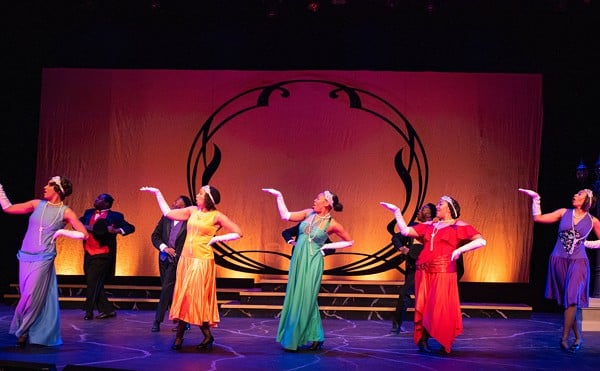The aesthetic difference between the French and Americans boils down to this: The French think Jerry Lewis is a genius. We think Jerry Lee Lewis is a genius. The French can suss deep symbolic meaning out of Jerry Lewis' silly shtick. Americans react to clear, energetic statements. Opera Theatre of Saint Louis, in the persons of stage director David Alden, set designer Paul Steinberg and lighting designer Adam Silverman, made all the right artistic decisions in their very American production of French composer Claude Debussy's only opera, Pelléas and Mélisande. Whether you enjoy it will depend on your reaction to Debussy's very French decision to use as the libretto Symbolist playwright Maurice Maeterlinck's play of the same name.
All art exists in a cultural context. The really great pieces escape their context by reaching the pinnacle of the artist's Everest: universal appeal. The context of Pelléas and Mélisande is the philosophic ferment of French intellectuals at the turn of the twentieth century, in particular, the Symbolist movement. There is something implacably French about the Symbolists. Symbolist literature strives to imbue every element the reader encounters with multiple levels of meaning. To wit, this from the 1886 Symbolist Manifesto: "...[S]cenes from nature, human activities, and all other real world phenomena will not be described for their own sake; here, they are perceptible surfaces created to represent their esoteric affinities with the primordial Ideals."
Like Jerry Lewis, this is not a recipe for universal appeal.
Maeterlinck's plot is a basic love triangle. Prince Golaud falls in love with the mysterious Mélisande, whom he encounters while hunting in the forest. They marry. When he brings her home, she falls in love with Pelléas, Goulaud's younger brother. Bloody tragedy ensues.
All in all a fine plot for an opera. But Maeterlinck inflicts upon his script a heaping helping of symbolic language, the sort of eructations that positively scream, "I'm sooo deep and sooo meaningful." These awkward stabs at "enhanced" meaning may have been revolutionary when audiences first witnessed them, but modern viewers are more likely to interpret them as clumsy camp.
Normally, in adapting a play for opera, a librettist replaces the dialogue with rhyming — or, at the very least rhythmic — language that can be set to music. Refrains and catchy phrases are inserted and set over memorable melodies. (Think "Great Balls of Fire.") Debussy, however, took Maeterlinck's exact words and wrote music to sing them over. As a result, Pelléas contains none of the conventional duets, trios or other ensemble pieces that enliven most operas. The characters never sing harmonies or counterpoint with one another. Instead, as in a play, everyone speaks in turn.
The result is a very modern — and very unconventional — opera.
Debussy's score is gorgeous. As a composer he is best known for his "tone poems" — multilayered harmonic confections with titles like "Reflections in the Water" and "Footsteps in the Snow." In Pelléas and Mélisande, he builds an almost linear series of these, underpinned with enough rhythmic drive and harmonic repetition to create and sustain drama. Conductor Stephen Lord and the orchestra masterfully expose every millimeter of theatricality in the score, yet they manage to preserve its exquisite subtlety and subtexts.
There are no arias; there really aren't even tunes. Instead the singers create lyrical, harmonic and dramatic arcs by accenting specific elements of the score. The leads in particular — buttery soprano Corinne Winters (Mélisande), richly expressive baritones Liam Bonner (Pelléas) and Gregory Dahl (Golaud), and spectacular twelve-year-old (you read that right) soprano Michael Meo — are unflagging in their creativity and musical good sense.
The set, staging and lighting are an intoxicating brew of early twentieth-century Gothic and postmodern elements. The set design is especially elegant, with eerily liquid scene changes wonderfully accented by shimmering lighting. Shadows ebb and flow to conceal and reveal cast members.
Debussy, an inveterate opium smoker, would have loved it.





